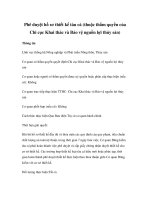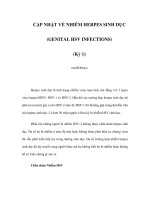CẬP NHẬT về THIẾT kế STENT PHỦ THUỐC
Bạn đang xem bản rút gọn của tài liệu. Xem và tải ngay bản đầy đủ của tài liệu tại đây (2.09 MB, 31 trang )
CẬP NHẬT VỀ
THIẾT KẾ
STENT PHỦ THUỐC
Assoc. Prof. Truong Quang Binh MD., PhD., FSCAI.
University Medical Center
3 Stent platform and delivery system
Drug-
Eluting
Stent
Drug-Eluting Stents
Sirolimus, Tacrolimus,
Zotarolimus , Biolimus,
Everolimus
Paclitaxel
Polymer
Drug load
Control Release
Pharmacologic
agent
Drug carrier
vehicle
Garg S, et al. Coronary artery stents. The PCR-EAPCI Percutaneous Interventional Cardiovascular Medicine Textbook, pp. 45-106.
Price MJ, et al. Fundamentals of Drug-Eluting Stent Design. Coronary stenting: A Companion to Topol’s Textbook of Interventional
Cardiology.
“DRUG CARRIER VEHICLE” OF DES
DES with durable polymer
(durable-polymer DES)
DES with biodegradable polymer
(biodegradable-polymer DES)
DES with Porous Polymer-free
(polymer-free DES)
Bioresorbable scaffolds (BRS)
DES with durable polymer
(durable-polymer DES)
Drug Carrier
Polymer
DES with durable polymer
(durable-polymer DES)
DES with durable polymer
(durable-polymer DES)
persistent arterial wall inflammation and delayed vascular healing
DES with biodegradable polymer
(biodegradable-polymer DES)
Once implanted into the
artery, the BIOlut begins
its controlled release of
drug
The BIOlute polymer
matrix gently breaks
down into CO
2
and H
2
O
causing minimal tissue
burden and avoids
inflammation
Following complete
absorption of the
polymer, only a PROBIO
coated stent is left behind
Biodegradable-polymer DES
The hybrid structure:
• * Passive component
PROBIO encapsulates
the stent, eliminating
interaction between the
metal stent and the
surrounding tissue
• * Active component
BIOlut contains a
bioabsorbable polymer
matrix combined with a
limus drug for optimal
results
The underlying PRO-Kinetic
Energy Stent System provides
superior deliverability with state-
of-the-art thin strut stent design
An ideal combination of passive and active components
Industry’s first hybrid drug eluting stent
with a bioabsorbable polymer
reducing the long-term risks associated with
the presence of a permanent polymer
Porous Polymer-free Drug Eluting
Stent (polymer-free DES)
Porous Polymer-free Drug Eluting
Stent (polymer-free DES)
Bioresorbable scaffolds (BRS)
BRS technology is anticipated not only to eliminate the
risk of VLST, but also to contribute to the restoration of
physiological function of treated vessels.
Bioresorbable scaffolds (BRS)
Clinical evaluation are required before
BRS can be accepted as the ultimate
device for the treatment of CAD.
This new technology looks promising
and could be the next revolution in
interventional cardiology.
16
Orsiro physician presentation, June 2014
Circumferential
7-8 µm/side
Circumferential
6 µm/side
Abluminal
10 µm
Abluminal
15 µm
Abluminal
4 µm
Circumferential
4-7 µm/side
Circumferential
3 µm/side
Overview of current DES stent designs
Sources: 1: GG Stefanini, M Taniwaki, S Windecker, Coronary stents: novel development, Heart doi:10.1136/heartjnl-2012-303522; 2: IT Meredith, Scientific symposium, TCT 2013
Strut and coating thickness in perspective
Durable
Polymer Coated Stent
Bioabsorbable
Polymer Coated Stent
Bioabsorbable
Scaffold
Strut thickness
81 µm 91 µm 120 µm 80 µm 74 µm 60 µm 150 µm
Polymer coating
Abbott/Boston Medtronic BIOSENSORS Terumo Boston
BIOTRONIK
Abbott
Xience/Promus
1
CoCr/PtCr-EES
Resolute
1
CoNi-ZES
BioMatrix
1
316L-BES
Ultimaster
1
CoCr-SES
Synergy
1
PtCr-EES
Orsiro
1
CoCr-SES
Absorb
2
PLLA-EES
Once implanted into the
artery, the BIOlut begins
its controlled release of
drug
The BIOlute polymer
matrix gently breaks
down into CO
2
and H
2
O
causing minimal tissue
burden and avoids
inflammation
Following complete
absorption of the
polymer, only a PROBIO
coated stent is left behind
ORSIRO stent (Biotronik)
ORSIRO:
Late Loss = 0.05
Restenosis = 0%
19
Orsiro physician presentation, June 2014
Study Study design
Total
patients
Primary
endpoint
Status
ClinicalTrials.gov
Identifier:
FIM
30
9 mo LLL
Primary endpoint reached
NCT01214148
RCT vs. Xience Prime
440
9 mo LLL
Primary endpoint reached
NCT01356888
International registry
1,000
12 mo TLF
Primary endpoint reached
NCT01553526
Satellite registries (8)
>3,000
12 mo TLF
Enrolling
*
RCT vs. Xience Prime
555
12 mo TVF
Enrolling
NCT01939249
Indian single-armed trial
120
9 mo LLL
Primary endpoint reached
NCT01426139
RCT vs. Pantera Lux in ISR
210
6 mo LLL
Enrolling
NCT01651390
RCT vs. Xience Prime
2,100
12 mo TLF
Enrollment completed
NCT01443104
SORT OUT VII
RCT vs. Nobori
2,314
12 mo TLF
Enrollment completed
NCT01879358
BIO-RESORT
RCT vs.
Synergy & Resolute integrity
3,530
12 mo TVF
Enrolling
(n=1,779; 20 May 2014)
NCT01674803
ORIENT
RCT vs. Resolute Integrity
345
9 mo LLL
Enrolling
NCT01826552
PRISON-IV
RCT vs. Xience Prime
330
9 mo LLL
Enrolling
NCT01516723
HAT-TRICK-OCT
RCT vs. Endeavor Resolute
40
3 mo
Strut coverage
Primary endpoint reached
NCT01391871
ORSIRO OCT
RCT vs. Xience Prime
60
6 & 24 mo
Strut coverage
Enrolling
NCT01594736
Total >14,000
Investigator initiated
BIOTRONIK initiated
The clinical program for Orsiro is
comprehensive and well underway
20
Orsiro physician presentation, June 2014
Clinical follow-up at 12 months
Clinical follow-up at 1 and 6- months
440 Patients with stable CAD
Clinical, angiographic, IVUS* and OCT*
follow-up at 9 months
Orsiro
2:1 randomization
* Pre-specified subgroups with
60 patients in each
Clinical follow-up to 5 years
Source: S. Windecker, Late breaking trial presentation, EuroPCR 2013
Xience Prime
DESIGN
An international, RCT comparing the
Orsiro hybrid DES to Xience Prime
OBJECTIVE
To compare the Orsiro stent with a
bioabsorbable polymer to the XIENCE
Prime
®
stent with a durable polymer
with respect to non-inferiority for in-
stent Late Lumen Loss (LLL) at 9-
months
PRIMARY ENDPOINT
In-Stent Late Lumen Loss at 9-month
21
Orsiro physician presentation, June 2014
452 patients randomized (ITT*)
between July 2011 and March 2012
298 Orsiro
Angio: n=298
IVUS: n=40
OCT: n=44
1-month FUP
Clinical: n =294 (99%)
6-month FUP
Clinical: n =293(98%)
9-month FUP
Clinical: n=288 (97%)
Angio: n=252 (85%)
IVUS: n=32
OCT: n=37
1-month FUP
Clinical: n =151 (98%)
6-month FUP
Clinical: n =151 (98%)
9-month FUP
Clinical: n=151 (98%)
Angio: n=131 (85%)
IVUS: n=23
OCT: n=17
2:1 Randomization
Clinical FUP yearly up to 5 years ongoing
154 Xience Prime
Angio: n=154
IVUS: n=26
OCT: n=21
Patient Flow
* ITT= Intention to treat
Source: S. Windecker, Late breaking trial presentation, EuroPCR 2013
22
Orsiro physician presentation, June 2014
Orsiro
(n=298)
Xience Prime
(n=154)
Age, years mean ± SD 62.7 ± 10.4 64.8 ± 9.2
Gender male (%) 78.2 74.7
Hypertension (%) 77.5 73.7
Hyperlipidemia (%) 67.8 73.4
History of MI (%) 30.2 20.1
Renal Insufficiency (%) 7.0 4.5
Congestive Heart Failure (%) 10.1 13.6
Diabetes (%) 28.2 28.6
Insulin dependent (%) 21.4 34.1
Non-insulin dependent (%) 78.6 65.9
Smoking (%) 66.4 57.8
History of stroke TIA (%) 7.0 6.5
Baseline clinical and lesion
characteristics
Source: S. Windecker, Late breaking trial presentation, EuroPCR 2013
23
Orsiro physician presentation, June 2014
Primary Angiographic
Endpoint
Cumulative frequency of in-stent late loss at 9 months (mm)
Orsiro
Xience
Prime
p-value
for non-
inferiority
0.10 ± 0.32 0.11 ± 0.29 < 0.0001
In-stent late lumen loss at 9 months (mm)
Source: S. Windecker, Late breaking trial presentation, EuroPCR 2013
24
Orsiro physician presentation, June 2014
Orsiro
(n=278
Lesions)
Xience Prime
(n=149
Lesions)
P
Diameter stenosis
(%)
In stent 9.52 ± 13.49 9.43 ± 10.78
0.89
In segment 19.48 ± 12.89 19.22 ± 12.25
0.96
Binary restenosis
(%)
In stent
6 (2.16%) 2 (1.34%) 0.56
In segment
11 (3.96%) 7 (4.70%) 0.72
Angiographic results
Source: S. Windecker, Late breaking trial presentation, EuroPCR 2013
25
Orsiro physician presentation, June 2014
Secondary clinical endpoint
TLF components at 12 months
No stent thrombosis
at 12 months
Xience Prime
Orsiro
TLF, composite of cardiac death, target vessel MI (Universal Definition),
clinically driven TLR and emergent CABG - time to first event
All events have been adjudicated by an independent clinical event committee
(%)
Source: S. Windecker, Scientific Symposia presentation, TCT 2013









